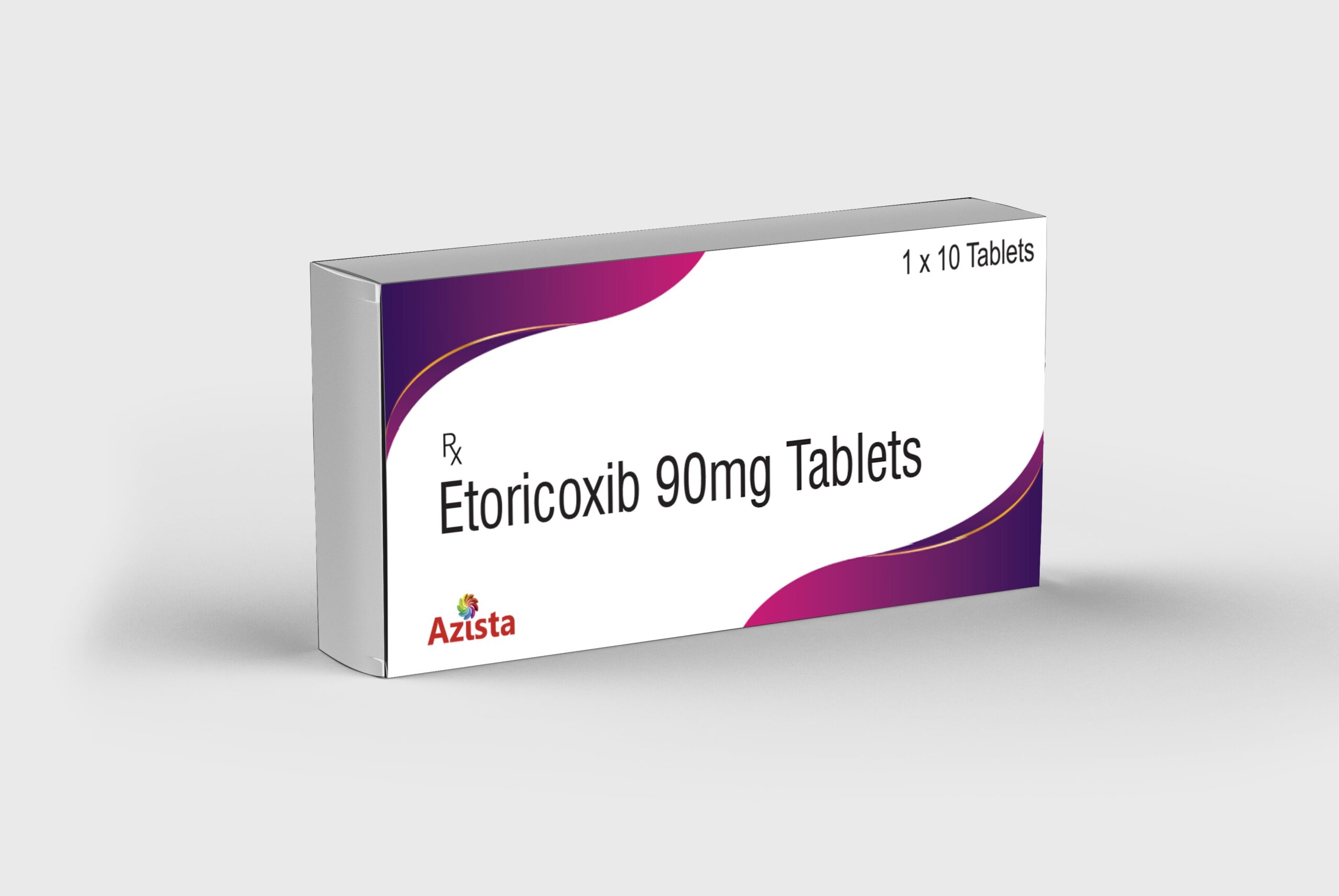Etoricoxib
Etoricoxib is a nonsteroidal anti-inflammatory drug (NSAID) belonging to the COX-2 inhibitor group. Compared to other conventional NSAIDs, etoricoxib tablets are the most effective. They reduce swelling and pain in conditions such as gout, ankylosing spondylitis, chronic back pain, osteoarthritis, and rheumatoid arthritis. This medication is also recommended for people with minor pain after dental procedures. The medication works by preventing the production of certain chemical messengers that cause inflammation and redness.
In addition, unlike other NSAIDs, this drug does not cause serious damage to the stomach. Therefore, this drug is often prescribed.
What is etoricoxib used for?
Etoricoxib is a painkiller. It relieves pain, stiffness, and swelling caused by various conditions, including ankylosing spondylitis (which causes pain and stiffness in the bones of the spine), osteoarthritis (which causes painful joints due to the wear and tear of the protective cartilage between two bones), rheumatoid arthritis (which causes swelling and pain in the small joints of the body), and more. According to recommendations, etoricoxib should not be used by people under 16 years of age. Also, tell your doctor if you are pregnant, planning to become pregnant, or breastfeeding before using this medication.
Application and dosage
Etoricoxib is available in injectable and tablet forms. Take etoricoxib orally as directed by your doctor. Etoricoxib can also be administered intravenously by a healthcare professional. Etoricoxib should be taken once daily, exactly as directed by your doctor. The dosage of the medication that is appropriate for your condition will be recommended. For example, patients with osteoarthritis are often prescribed 30 mg once daily. However, the dosage can be increased to 60 mg if needed. Before taking etoricoxib, read the printed manufacturer’s leaflet inside the package. This will provide more information about the medication and a comprehensive list of possible side effects.
Take the tablets with a drink of water. You can take the medication with or without food. However, taking it without food may help the medication work faster. Try to take your tablets at the same time every day to make it easier to remember.
Side effects of etoricoxib
The following side effects may occur:
- Abdominal pain, stomach discomfort and digestive problems
- Dizziness or fatigue
- Diarrhea or constipation
- Swelling of the ankles, fluid retention, palpitations, shortness of breath, bruising, headaches and flu-like symptoms.
You should stop taking etoricoxib immediately and seek medical help if you experience any of the following rare but potentially dangerous symptoms:
- Breathing problems such as wheezing or shortness of breath
- Signs of an allergic reaction such as swelling around the lips or face or a severe itchy skin rash
- For severe abdominal pain, black stools, blood in vomit or blood in urine.
Precautions
Tell your doctor if you have a history of stomach bleeding or ulcers, liver or kidney disease, dehydration due to prolonged vomiting or diarrhea, or edema due to fluid retention before using etoricoxib.
Tell your doctor if you have untreated or uncontrolled high blood pressure, as etoricoxib may increase blood pressure in some people.
Vermeiden Sie die Verwendung von Etoricoxib, wenn Sie wegen einer Erkrankung behandelt werden, da es das Fieber verschlimmern könnte.
Wenn Sie rauchen, Diabetes haben oder einen hohen Cholesterinspiegel haben, sollten Sie Etoricoxib nicht verwenden, da dies Ihr Risiko für einen Herzinfarkt oder Schlaganfall erhöhen könnte.
Vermeiden Sie es, nach der Einnahme von Etoricoxib mindestens 30 Minuten lang zu liegen.
Etoricoxib sollte nicht von Personen eingenommen werden, die einen Herzinfarkt oder Schlaganfall erlitten haben.
Dieses Medikament wird schwangeren Frauen nur verabreicht, wenn es unbedingt notwendig ist. Sprechen Sie vor der Anwendung dieses Medikaments mit Ihrem Arzt über alle Risiken und Vorteile. Ihr Arzt kann je nach Ihrem Gesundheitszustand eine risikoärmere Option vorschlagen.
Was tun bei vergessener Dosis oder Überdosierung von Etoricoxib?
Nehmen Sie die vergessene Dosis des Medikaments ein, sobald Sie sich daran erinnern. Wenn die vergessene Dosis zur geplanten Zeit fällig ist, lassen Sie die nächste geplante Dosis aus. Nehmen Sie keine doppelte Dosis ein, um eine vergessene Dosis auszugleichen.
Mögliche Symptome einer Überdosierung sind Bauchschmerzen, Übelkeit, Atemprobleme und sogar Koma. Wenn Sie denken, dass Sie zu viel eingenommen haben, suchen Sie sofort medizinische Hilfe.
Lagerungsbedingungen für Etoricoxib
Halten Sie alle Medikamente außerhalb der Sicht und Reichweite von Kindern.
Bewahren Sie das Medikament an einem kühlen, trockenen Ort fern von direkter Hitze und Licht auf.
Bewahren Sie keine abgelaufenen oder nicht benötigten Medikamente auf und entsorgen Sie diese ordnungsgemäß.
Wechselwirkungen mit anderen Medikamenten
Wechselwirkungen mit anderen Medikamenten:
- Methotrexat, Ciclosporin, Tacrolimus
- Diuretika
- Antibiotika wie Rifampicin
- Orale hormonelle Verhütungspillen
- Blutverdünner wie Warfarin
- Lithium – ein Medikament zur Behandlung von Manie
Die gleichzeitige Verwendung von Etoricoxib und Aspirin erhöht das Risiko von Magenulzera.
Wie schnell zeigt Etoricoxib Wirkung?
Eine einzelne Dosis von Etoricoxib beginnt innerhalb einer Stunde Schmerzen zu lindern, aber wiederholte Dosen über einige Wochen führen dazu, dass es wirksamer bei der Reduktion von Entzündungen wird.
Vergleich von Etoricoxib mit Naproxen
| Etoricoxib | Naproxen | |
|---|---|---|
| Zusammensetzung | Etoricoxib ist der Wirkstoff in diesem Medikament. Etoricoxib ist in filmüberzogenen Tabletten in Dosen von 30, 60, 90 oder 120 mg erhältlich. | Naproxen-Natrium ist bei pH 7 ein frei lösliches, kristallines Feststoff, der von weiß bis cremig-weiß reicht. |
| Verwendung | Bei arthritischen Erkrankungen wie Osteoarthritis, ankylosierender Spondylitis und rheumatoider Arthritis reduziert Etoricoxib Entzündungen und lindert Schmerzen. | Naproxen ist ein nichtsteroidales entzündungshemmendes Medikament (NSAID). Es lindert Gelenk- und Muskelbeschwerden sowie Schwellungen (Entzündungen). |
| Nebenwirkungen | Fatigue, diarrhea or constipation, high blood pressure, abdominal pain, tiredness, difficulty breathing, blurred vision, drowsiness, rash, severe digestive problems, frequent sore throats. |
FAQs
- What is etoricoxib used for?
Etoricoxib is a nonsteroidal anti-inflammatory drug (NSAID) used to relieve pain and inflammation in conditions such as osteoarthritis, rheumatoid arthritis, ankylosing spondylitis, and acute gouty arthritis. - How does etoricoxib work?
Etoricoxib works by inhibiting the action of certain enzymes (COX-2) responsible for the production of prostaglandins, which play a role in inflammation and pain. By reducing prostaglandin levels, etoricoxib helps relieve pain and inflammation. - Can etoricoxib be used for acute pain?
Etoricoxib is primarily used for chronic conditions associated with pain and inflammation, such as osteoarthritis and rheumatoid arthritis. It is not typically used to treat acute pain. - What are the most common side effects of etoricoxib?
The most common side effects may include headache, dizziness, edema, and gastrointestinal problems such as indigestion. Serious side effects are rare but may include gastrointestinal bleeding, cardiovascular events, and liver problems. - Can etoricoxib be taken with food?
Etoricoxib can be taken with or without food. However, taking it with food may help reduce the risk of gastrointestinal side effects.








Reviews
There are no reviews yet.